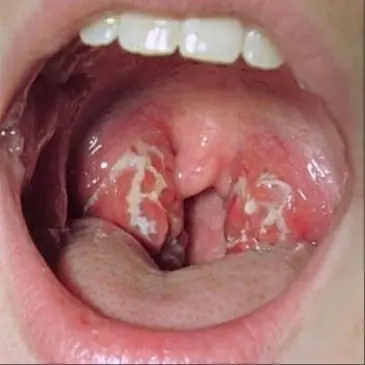Content :
Mononucleosis is a common viral infection that mainly affects adolescents and young adults. In this article, we'll take a closer look at infectious mononucleosis, including its causes, modes of transmission, characteristic symptoms, diagnostic methods, and available treatment options.
◉ What is mononucleosis?
Mononucleosis , also called “mono”, is a contagious disease characterized by fever, extreme fatigue, sore throat and enlarged cervical lymph nodes.
It corresponds to the symptomatic primary infection caused by the Epstein-Barr virus, also called EBV or HHV-4, which belongs to the herpes virus family.
Mono occurs most often in adolescents and young adults, more than 90% of the world's adult population are HIV positive. However, you can catch it at any age.
Mononucleosis gets its name because the virus causes an overgrowth of monocytes (a type of white blood cell) in the blood.
Note: The Epstein-Barr virus is the most common cause of infectious mononucleosis, but other viruses can also cause this disease.

◉ What causes mononucleosis?
Although the Epstein-Barr virus (EBV) is the most common cause of mononucleosis, there are other viruses and infections that can cause similar symptoms. These include:
- Cytomegalovirus (CMV): occurs mainly in patients whose immune defenses have been weakened.
- Adenovirus.
- Rubella.
- HIV: virus responsible for AIDS.
- Toxoplasmosis: is an infectious disease caused by a parasite that animals transmit to humans.
- HAV: Hepatitis A virus.
- HBV: Hepatitis B virus.
- HCV: Hepatitis C virus.
◉ How do you get mononucleosis?
This virus is very contagious, typically it spreads through bodily fluids, especially saliva hence the name kissing disease. But also by:
- Respiratory tract: sneezing and coughing.
- Blood and semen during sexual contact.
- Blood transfusions.
- Organ transplants or hematopoietic cell transplantation.
People with mononucleosis can be contagious from the time they are first infected before symptoms appear (incubation period is 4-6 weeks before symptoms appear) .
◉ What are the symptoms of mononucleosis?
Infections during childhood are often silent or benign, whereas in the rare people who acquire the infection for the first time beyond their 30th year, the symptomatology is atypical and can cause significant morbidity.
The symptoms of mononucleosis can develop slowly, may not all occur at the same time, and each person may experience them differently:
- Extreme fatigue: usually take two to four weeks to improve.
- Fever: often above 39°C with a peak in the afternoon or early evening.
- Thrill
- Swollen lymph nodes in the neck and armpits
- Sore throat with or without white patches or membranes at the back of the throat.
- Headaches and body aches
- Enlargement of the spleen.
- Enlarged liver (with or without jaundice)
- Rash (often after taking antibiotics).
Other less common symptoms: swollen eyes, nausea, sensitivity to light, chest pain and difficulty breathing.
Note :
- Young children usually have milder symptoms, such as mild fever, fatigue and lack of appetite.
- Sometimes symptoms can last for 6 months or more.
Possible Complications of Mononucleosis
People with weakened immune systems may develop more serious symptoms and complications :

If you have symptoms similar to those of infectious mononucleosis, it is recommended that you consult a healthcare professional for an accurate diagnosis and appropriate treatment. Laboratory tests may be needed to identify the pathogen responsible for the infection.
◉ Diagnosis of mononucleosis
The doctor may suspect mono based on your signs and symptoms, how long they lasted, and a physical exam
The presence of the triad of clinical signs: fever, pharyngitis with large red tonsils covered with whitish membranes and large glands in the neck is characteristic of infectious mononucleosis.
Your doctor may also order blood tests developed to help diagnose mononucleosis:
Complete blood count: Your doctor will examine your white blood cells (lymphocytes), not only may the lymphocyte count be elevated, but the cells may also appear atypical ("atypical lymphocytes").
Heterophile Antibody Detection: Mononucleosis causes white blood cells to make an unusual type of antibody called a heterophile antibody. Among the tests used to measure these heterophile antibodies:
- MNI test (or Mono-Spot, non-specific)
- Paul-Bunnell-Davidsohn reaction
- Detection of specific anti-EBV antibodies (anti-VCA IgM, anti-VCA IgG, anti-EA IgG and IgG anti-EBNA).
Note :
- Rapid strep antigen testing is usually indicated to rule out strep throat
- HIV serology to exclude acute HIV infection.
◉ Management and Treatment of Mononucleosis
Infectious mononucleosis is usually self-limiting, so only symptomatic treatments are used (there is no specific treatment).
Antibiotics are not effective against mono. It is caused by a virus. Antibiotics do not work against viruses
Most treatments aim to make the person more comfortable
- Get plenty of rest
- Plenty of fluids to stay hydrated
- Analgesics such as acetaminophen or nonsteroidal anti-inflammatory drugs, for fever and pain
- Corticosteroid medications for throat swelling
If you suspect you have mononucleosis, it is important to see your doctor for an accurate diagnosis and treatment plan.
◉ Prevention
There is no vaccine to prevent mononucleosis. Stay away from people you know who have it (do not kiss or share drinks, food or personal items, such as toothbrush).
Avoid strenuous activity for at least 2 months and until your doctor finds that your spleen is no longer enlarged. Risk of rupture of the spleen.
◉ Frequently Asked Questions
Can you get mononucleosis more than once?
The Epstein-Barr virus remains in your body in an inactive form. But most people only develop mono once.
Is mononucleosis a sexually transmitted infection?
Yes. However, EBV is more likely to be spread through other means, such as sharing drinks or kissing.
Is mononucleosis serious?
In general, it is not considered a serious illness. However, in rare cases, can lead to serious illness.
How long does mononucleosis last?
Most people begin to recover within 2 weeks, although some symptoms, such as fatigue, may take 3-4 weeks or longer to resolve.
Mononucleosis rash?
Rash is not the most common symptom of IMD, however, it can be a sign of infection, especially if you have taken an antibiotic EX: Amoxicillin. The rash may consist of flat, pinkish-red spots on the skin. Some of these spots contain small, raised, pinkish-red lesions.
Can children go to school with mononucleosis?
Children with mono are generally not recommended to go to school until their symptoms have improved and they feel better. Indeed, this infectious disease is very contagious and can spread through close contact with saliva, such as sharing utensils or drinks.